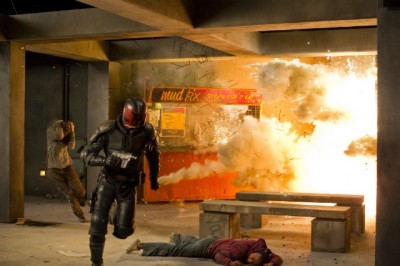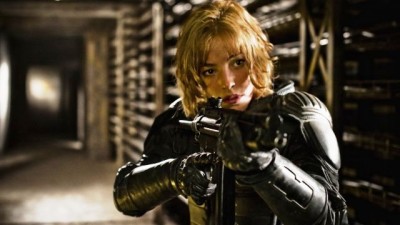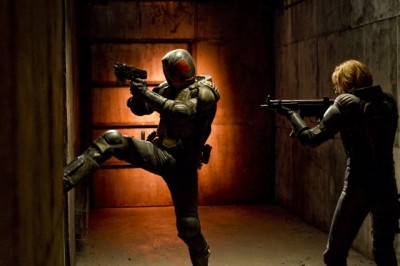
Peter Travis’ Dredd finds itself in an unusual position and poses an unusual quandary. You see, the film has the misfortune of bearing more than a passing resemblance to Gareth Evans’ The Raid: Redemption, which came out last spring. The films have similar plots, settings and styles. But the fact is that not only were the films being made at the same time, the Dredd screenplay by Alex Garland (Sunshine) apparently pre-dates The Raid. In other words, the marked similarities are completely coincidental. Ideally, Dredd ought to be judged on its own merits, but how is that really possible? It’s not like we can unwatch The Raid, and so it hangs over Dredd regardless of whether or not it owes anything to it. And the film comes up short by inevitable comparison. Dredd isn’t without merit, but regardless of the facts in the case, it feels like going down a path already covered.

Just like The Raid, this film is about cops trapped in a high-rise while being engaged in all-out war with the drug lord/crime boss and her seemingly limitless supply of henchman. That’s about it for both movies — though The Raid offers more characterization and adds other elements, while Dredd is really stripped down to the basics. In Dredd, we’re in some futuristic dystopian (is there any other kind of movie future?) world where one gigantic sprawl of urban decay extends from D.C. to Boston. What law and order there is is handled by “judges,” who in reality serve as judge, jury and, if need be, executioner. Before getting down to the central situation, we get a taste of this legal process in action with (of course) Judge Dredd (Karl Urban, who spends the entire film under that helmet). This scene is actually more entertaining and amusing than the rest of the movie.

Soon Dredd finds himself saddled with a rookie named Anderson (Olivia Thirlby, Being Flynn), whose specialty is her psychic powers, which come in handy in more ways than one, including rendering her unable to wear her helmet — making it easy to tell her from Judge Dredd. (This sort of confusion becomes a real problem later in the film when he goes up against some corrupt judges.) The central story comes into play when drug kingpin (queenpin?) Ma-Ma (TV actress Lena Headey) decides to have some bungling underlings skinned and tossed from the heights of her quarters in a high-rise in the slums. Dredd and Anderson are near the splattery results and investigate, which becomes complicated when Anderson’s psychic hoo-ha clues her in that Kay (TV actor Wood Harris) is the underling skinner. But since she can’t be 100 percent sure, the plan is to take him in and sweat him out — something Ma-Ma can’t have because he knows too much about her operation involving the drug “slo-mo.”

The rest of the film is one long shoot-out or series of shoot-outs. Some of them are clever, some are kind of perfunctory, but they’re ultimately on the repetitive side. The drug in question — a concoction that comes in what looks like an asthma inhaler — induces the sense of slow-motion in its users (turning the world into something that looks like that TV show that consists of watching things blow up or splatter in very slow motion). Worse, it seems to do the same thing to the director. So we are forced to watch repeatedly in that mode. It wears thin pretty quickly, though it does provide (with the addition of a glass floor) one unique bit for the annals of splatter — assuming that’s your idea of a good time. All in all, it is what it is — bloody, violent and reasonably efficient. Rated R for strong bloody violence, language, drug use and some sexual content.




one gigantic sprawl of urban decay extends from D.C. to Boston.
I hate to stoop to the obvious joke, but…isn’t this already essentially the case?
Well, as a die-hard East Coaster, I have to say no.